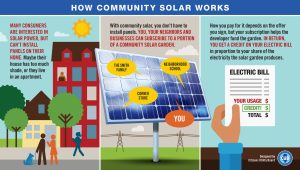Community Solar in Illinois
What is community solar?
Are you interested in solar power but prevented from installing solar panels because you can’t afford it, don’t have enough space or sunlight on your property, or live in an apartment?
Illinois’ community solar program allows electricity customers to enjoy the benefits of solar energy without installing panels on their own homes.
Through community solar, you can purchase a portion of the electricity produced by a solar installation—called a community solar garden—and in return receive credits on your electric bill.
Why is this possible now?
The 2016 Future Energy Jobs Act created Illinois’ community solar program, and the 2021 Climate and Equitable Jobs Act (CEJA) strengthened it. CEJA allocated funding for 250 MW of pending projects–for about 40,000 subscribers–and then about 150 MW per year of projects going forward.
How does community solar work?
Under Illinois’ community solar program, subscribers enter into an agreement that helps fund a solar installation somewhere in their utility’s service territory in exchange for a credit on their bills.
The owner of the community solar garden pays the upfront costs to build, maintain and connect the garden to the utility’s power grid. Subscribers pay the owner for their portion of the electricity produced. The owner then reports the output of each solar subscription to the utility, and the utility company adds credits to the subscriber’s electric bill equal to that output.
Here’s how it works: Let’s say your home uses 1,000 kilowatt hours (kWh) of electricity in a month, and your portion of the solar garden you subscribe to produces 950 kWh in that same month. You would receive a credit on your bill amounting to your supply rate multiplied by 950 kWh, meaning that month you would only need to pay for the remaining 50 kWh.
Then you receive a separate bill from your community solar provider for that 950 kWh generated by your subscription. Currently, all community solar companies in Illinois offer savings by charging you lower than what you would have paid ComEd or Ameren. Compare community solar offers on our Solar in the Community site.
How do I know what a good deal is?
The Illinois Commerce Commission and the Illinois Power Agency have to sign off on community solar contracts, so there are consumer protections. But some offers might be better for you than others.
Questions to ask when deciding between community solar offers:
– How long is the term of the contract?
– Does the company charge a fee if you exit the contract early?
– How do you pay for your subscription? If it is per kilowatt-hour, what is the rate? Can that rate increase over the time of the contract?
– Do they require a credit check?
– How will the company bill you? Electronically? A paper bill? How do they accept your payments? Can you choose? Do they require automatic payments?
– How much will you save? So far, people are expected to save anywhere from 10 to 20 percent on the electricity produced through their community solar subscription.
Important Info about Community Power Deals— While community solar is a good deal for most consumers, you should always do the math. In the current market, community solar may not be the best deal if you are on a municipal aggregation deal (also called a community power deal) that has a lower price than the utility rate. Municipal aggregation deals involve community leaders negotiating an electricity price with an alternative supplier. If your community has a community power deal and you have questions about community solar, please contact Marina Minic at CUB, [email protected].
Frequently asked questions
What are the benefits of community solar?
It can lower electric bills for subscribers and improve the power grid’s reliability. Also, adding solar power to the grid lessens the need for expensive power plants, lowering market prices for all.
Who can be a subscriber?
All residential and business customers can subscribe to a community solar garden—as long as it’s located in their electric utility’s service territory. The minimum subscription per customer is 200 watts, or about one solar panel. No individual can subscribe to more than 40 percent of a project, but you can subscribe to multiple projects.
Do subscribers directly receive power from the solar garden?
No. Unlike a home with its own solar panels, there’s no way to send the power generated by a solar garden exclusively to a subscriber’s home. Like all electricity, power produced by a solar garden is sent to the utility’s grid and distributed indiscriminately the moment it’s created.
What if you move?
If you move to a new home within your utility’s territory, you can continue your subscription. If you move outside the territory, you must cancel your subscription or transfer it to another customer who meets the eligibility requirements.
Will you pay a fee if you end your subscription early?
You probably will have to pay a termination fee. That’s a good question to ask when you are considering a community solar project. Also ask if you are required to participate for a certain number of years.


